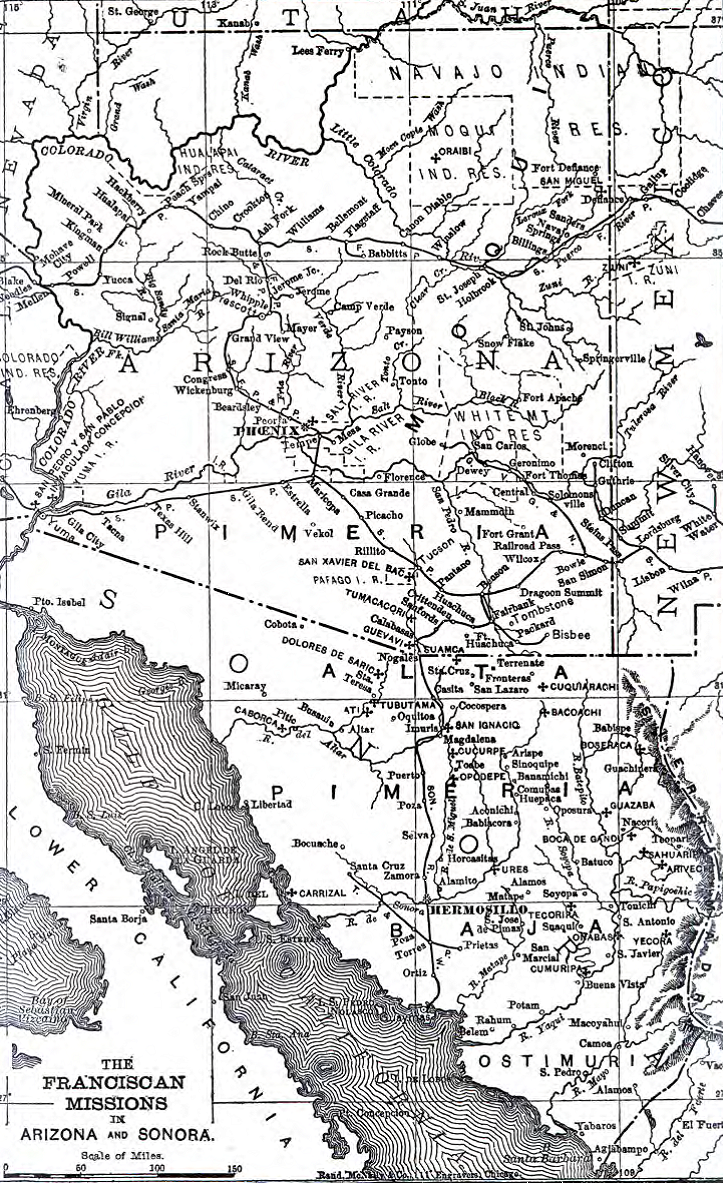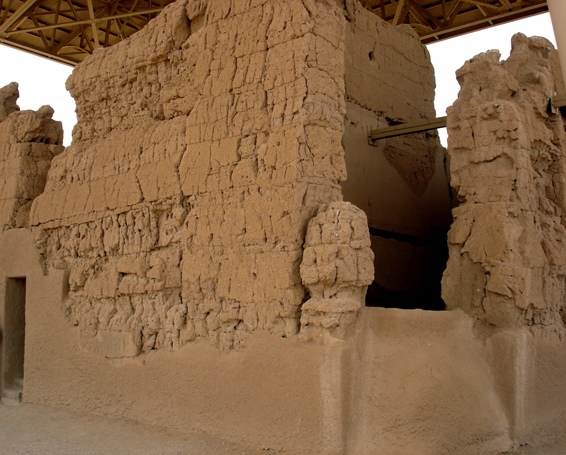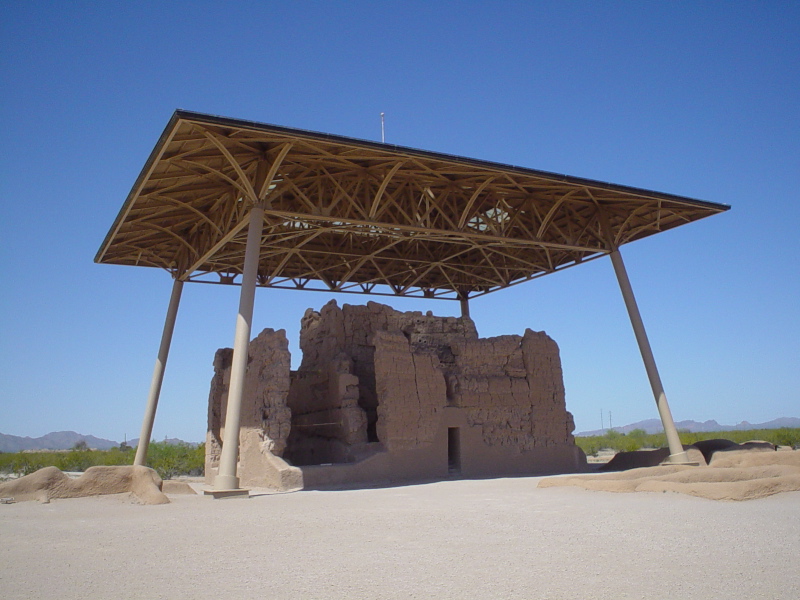|
Sobaipuri
The Sobaipuri were one of many Indigenous groups occupying Sonora and what is now Arizona at the time Europeans first entered the American Southwest. They were a Piman or O'odham group who occupied southern Arizona and northern Sonora (the Pimería Alta) in the 15th–19th centuries. They were a subgroup of the O'odham or Pima, surviving members of which include the residents of San Xavier del Bac which is now part of the Tohono O'odham Nation and the Akimel O'odham. Debate sometimes still arises as to whether the Sobaipuri and other O'odham groups are related to the prehistoric Hohokam who occupied a portion of the same geographic area and were present until about the 15th century. This question is sometimes phrased as the "Hohokam-Pima" or "Salado-Pima continuum", a phraseology that questions whether there is a connection between the prehistoric Hohokam and the first historic groups cited in the area. A key piece of the puzzle has recently been found when it was discovered t ... [...More Info...] [...Related Items...] OR: [Wikipedia] [Google] [Baidu] |
Spanish Missions In The Sonoran Desert
The Spanish missions in the Sonoran Desert () are a series of Jesuit Catholic religious outposts established by the Spain, Spanish Roman Catholic, Catholic Society of Jesus, Jesuits and other orders for religious conversions of the Pima people, Pima and Tohono O'odham Indigenous peoples of the Americas, indigenous peoples residing in the Sonoran Desert. An added goal was giving Spain a Spanish colonization of the Americas, colonial presence in their frontier territory of the Sonora y Sinaloa, Sonora y Sinaloa Province in the Viceroyalty of New Spain, and relocating by Indian Reductions (''Reducciones de Indios'') settlements and encomiendas for agricultural, ranching, and mining labor. Geography and history The missions are in an area of the Sonoran Desert, then called "Pimería Alta de Sonora y Sinaloa" (Upper Pima of Sonora and Sinaloa), now divided between the Mexican state of Sonora and the U.S. state of Arizona. Jesuits in missions in Northwestern Mexico wrote reports that ... [...More Info...] [...Related Items...] OR: [Wikipedia] [Google] [Baidu] |
Eusebio Kino
Eusebio Francisco Kino, Jesuits, SJ (, ; 10 August 1645 – 15 March 1711), often referred to as Father Kino, was an Italian Jesuit, missionary, geographer, explorer, cartographer, mathematician and astronomer born in the Prince-Bishopric of Trent, Bishopric of Trent, Holy Roman Empire. For the last 24 years of his life he worked in the region then known as the Pimería Alta, modern-day Sonora in Mexico and southern Arizona in the United States. He explored the region and worked with the indigenous Indigenous peoples of the Americas, Native American population, including primarily the Tohono O'Odham, Sobaipuri and other Upper Piman groups. He proved that the Baja California Peninsula, Baja California Territory was not an Island of California, island but a peninsula by leading an overland expedition there. By the time of his death he had established 24 Spanish missions in Arizona, missions and visitas (country chapels or visiting stations). Early life Kino was born Eusebio Chini ... [...More Info...] [...Related Items...] OR: [Wikipedia] [Google] [Baidu] |
Mission Los Santos Ángeles De Guevavi
La Misión de San Gabriel de Guevavi was founded by Jesuit missionary priests Eusebio Kino and Juan María de Salvatierra in 1691. Subsequent missionaries called it San Rafael and San Miguel, resulting in the common historical name of Mission Los Santos Ángeles de Guevavi (). Located in what is now Arizona, near Tumacácori, the mission served as a district headquarters for the Jesuits. History The mission location was originally a native Sobaipuri or O'odham (Upper Pima) settlement, which Eusebio Kino visited in 1690. The mission was established in 1691, with Juan de San Martín as resident priest. By the late 1690s, the mission consisted of a church, a carpentry shop, and a blacksmith's area. Under Jesuit supervision, Pima laborers built a small chapel in 1701, using adobe bricks and basic tools. Guevavi was designated as ''cabecera'' (headquarters) that same year. Juan de San Martín left the mission in 1701, leaving it to be administered remotely by , Ignacio Xavier ... [...More Info...] [...Related Items...] OR: [Wikipedia] [Google] [Baidu] |
San Pedro River (Arizona)
The San Pedro River is a northward-flowing stream originating about south of the international border south of Sierra Vista, Arizona, in Cananea Municipality, Sonora, Mexico. The river starts at the confluence of other streams (Las Nutrias and El Sauz) just east of Sauceda, Cananea. Within Arizona, the river flows north through Cochise County, Arizona, Cochise County, Pima County, Arizona, Pima County, Graham County, Arizona, Graham County, and Pinal County, Arizona, Pinal County to its confluence with the Gila River, at Winkelman, Arizona. It is the last major undammed desert river in the Southwestern United States, American Southwest, and it is of major ecological importance as it hosts two-thirds of the avian diversity in the United States, including 100 species of breeding birds and almost 300 species of migrating birds. History The first people to enter the San Pedro Valley were the Clovis people who hunted mammoth here from 10,000 years ago. The San Pedro Valley has the ... [...More Info...] [...Related Items...] OR: [Wikipedia] [Google] [Baidu] |
Hohokam
Hohokam was a culture in the Indigenous peoples of the North American Southwest, North American Southwest in what is now part of south-central Arizona, United States, and Sonora, Mexico. It existed between 300 and 1500 CE, with cultural precursors possibly as early as 300 BCE. Archaeologists disagree about whether communities that practiced the culture were related or politically united. According to local oral tradition, Hohokam societies may be the ancestors of the historic Akimel Oʼodham, Akimel and Tohono Oʼodham in Southern Arizona. The origin of the culture is debated. Most archaeologists either argue it emerged locally or in Mesoamerica, but it was also influenced by the Northern Pueblo culture. Hohokam settlements were located on trade routes that extended past the Hohokam area, as far east as the Great Plains and west to the Pacific coast. Hohokam societies received a remarkable amount of immigration. Some communities established significant markets, such a ... [...More Info...] [...Related Items...] OR: [Wikipedia] [Google] [Baidu] |
Pima People
The Akimel O'odham (Oʼodham language, O'odham for "river people"), also called the Pima, are an Indigenous people of the Americas living in the United States in central and southern Arizona and northwestern Mexico in the states of Sonora and Chihuahua (state), Chihuahua. The majority population of the two current bands of the Akimel O'odham in the United States is based in two reservations: the Keli Akimel Oʼodham on the Gila River Indian Community (GRIC) and the On'k Akimel O'odham on the Salt River Pima-Maricopa Indian Community (SRPMIC). The Akimel O'odham are closely related to the Ak-Chin O'odham, now forming the Ak-Chin Indian Community. They are also related to the Sobaipuri, whose descendants reside on the San Xavier Indian Reservation or Wa꞉k (together with the Tohono O'odham), and in the Salt River Indian Community. Together with the related Tohono O'odham ("Desert People") and the Hia C-ed O'odham ("Sand Dune People"), the Akimel O'odham form the Upper O'odham. N ... [...More Info...] [...Related Items...] OR: [Wikipedia] [Google] [Baidu] |
San Xavier Del Bac
Mission San Xavier del Bac () is a historic Spanish Catholic mission about south of downtown Tucson, Arizona, on the Tohono O'odham Nation San Xavier Indian Reservation. The mission was founded in 1692 by Eusebio Kino in the center of a centuries-old settlement of the Sobaipuri O'odham, a branch of the Akimel or River O'odham located along the banks of the Santa Cruz River. The mission was named for Francis Xavier, co-founder of the Jesuit Order in Europe. The original church was built to the north of the later Franciscan church and was demolished during an Apache raid in 1770. The mission was rebuilt between 1783 and 1797, which makes it the oldest European structure in Arizona. Labor was provided by the O'odham. An outstanding example of Spanish Colonial architecture in the United States, the Mission San Xavier del Bac hosts some 200,000 visitors each year. It is a well-known pilgrimage site, with thousands visiting each year on foot and on horseback, some among ceremonial ... [...More Info...] [...Related Items...] OR: [Wikipedia] [Google] [Baidu] |
Akimel O'odham
The Akimel O'odham (Oʼodham language, O'odham for "river people"), also called the Pima, are an Indigenous people of the Americas living in the United States in central and southern Arizona and northwestern Mexico in the states of Sonora and Chihuahua (state), Chihuahua. The majority population of the two current bands of the Akimel O'odham in the United States is based in two reservations: the Keli Akimel Oʼodham on the Gila River Indian Community (GRIC) and the On'k Akimel O'odham on the Salt River Pima-Maricopa Indian Community (SRPMIC). The Akimel O'odham are closely related to the Ak-Chin O'odham, now forming the Ak-Chin Indian Community. They are also related to the Sobaipuri, whose descendants reside on the San Xavier Indian Reservation or Wa꞉k (together with the Tohono O'odham), and in the Salt River Indian Community. Together with the related Tohono O'odham ("Desert People") and the Hia C-ed O'odham ("Sand Dune People"), the Akimel O'odham form the Upper O'odham. N ... [...More Info...] [...Related Items...] OR: [Wikipedia] [Google] [Baidu] |
Pimería Alta
The ''Pimería Alta'' (translated to 'Upper Pima Land'/'Land of the Upper Pima' in English) was an area of the 18th century Sonora y Sinaloa, Sonora y Sinaloa Province in the Viceroyalty of New Spain, that encompassed parts of what are today southern Arizona in the United States and northern Sonora in Mexico. The area took its name from the Pima people, Pima and closely related O'odham (''Papago'') peoples residing in the Sonoran Desert. Pimería Alta was the site of the Spanish missions in the Sonoran Desert established by the Jesuit missionary Eusebio Kino in the late 17th and early 18th centuries. A significant Pima Indian Revolt, Pima rebellion against Spanish rule occurred in 1751. Terminology The term Pimería Alta first appeared in Spanish colonial documents (especially produced by those in the History of the Catholic Church in Mexico, Catholic Church) to designate an ethno-territorial expanse that spanned much of what is now southern Arizona and northern Sonora. The term ... [...More Info...] [...Related Items...] OR: [Wikipedia] [Google] [Baidu] |
Tumacácori National Historical Park
Tumacácori National Historical Park is located in the upper Santa Cruz River Valley in Santa Cruz County, southern Arizona. The park consists of in three separate units. The park protects the ruins of three Spanish mission communities, two of which are National Historic Landmark sites. It also contains the landmark 1937 Tumacácori Museum building, also a National Historic Landmark. History The first Spanish Colonial Jesuit missions in the locale were established in 1691 by Padre Eusebio Kino. Mission San Cayetano de Tumacácori (at Tumacácori) and Mission Los Santos Ángeles de Guevavi, are the two oldest missions in southern Arizona. The Franciscan church of Mission San José de Tumacácori, across the river from and replacing Mission San Cayetano de Tumacácori, was built in the 1750s. The third mission was established in 1756, Mission San Cayetano de Calabazas. The Mission San José de Tumacácori complex is open to the public. Nearby are the park's visitor cent ... [...More Info...] [...Related Items...] OR: [Wikipedia] [Google] [Baidu] |
Arizona
Arizona is a U.S. state, state in the Southwestern United States, Southwestern region of the United States, sharing the Four Corners region of the western United States with Colorado, New Mexico, and Utah. It also borders Nevada to the northwest and California to the west, and shares Mexico-United States border, an international border with the Mexican states of Sonora and Baja California to the south and southwest. Its Capital city, capital and List of largest cities, largest city is Phoenix, Arizona, Phoenix, which is the most populous state capital and list of United States cities by population, fifth most populous city in the United States. Arizona is divided into 15 List of counties in Arizona, counties. Arizona is the list of U.S. states and territories by area, 6th-largest state by area and the list of U.S. states and territories by population, 14th-most-populous of the 50 states. It is the 48th state and last of the contiguous United States, contiguous states to be a ... [...More Info...] [...Related Items...] OR: [Wikipedia] [Google] [Baidu] |
Southwest Tribes
The points of the compass are a set of horizontal, radially arrayed compass directions (or azimuths) used in navigation and cartography. A ''compass rose'' is primarily composed of four cardinal directions—north, east, south, and west—each separated by 90 degrees, and secondarily divided by four ordinal (intercardinal) directions—northeast, southeast, southwest, and northwest—each located halfway between two cardinal directions. Some disciplines such as meteorology and navigation further divide the compass with additional azimuths. Within European tradition, a fully defined compass has 32 "points" (and any finer subdivisions are described in fractions of points). Compass points or compass directions are valuable in that they allow a user to refer to a specific azimuth in a colloquial fashion, without having to compute or remember degrees. Designations The names of the compass point directions follow these rules: 8-wind compass rose * The four cardinal directio ... [...More Info...] [...Related Items...] OR: [Wikipedia] [Google] [Baidu] |








